Introduction
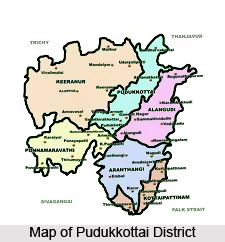 Pudukkottai district was carved out of the district of Tiruchirappalli and the district of Thanjavur in the month of January 1974. The district of Pudukkottai is spread over an area of four thousand six hundred and sixty three square kilometres and it possesses a coast line of about thirty nine kilometres. This district in the state of Tamil Nadu is located between seventy eight degree twenty five minutes and seventy nine degree fifteen minutes to the Eastern longitude and between nine degree fifty minutes and ten degree forty minutes to the Northern latitude. Pudukkottai district shares its borders with the district of Tiruchirappalli to the North and West, district of Shivaganga to the South, the Bay of Bengal to the East and the district of Thanjavur to the North-East.
Pudukkottai district was carved out of the district of Tiruchirappalli and the district of Thanjavur in the month of January 1974. The district of Pudukkottai is spread over an area of four thousand six hundred and sixty three square kilometres and it possesses a coast line of about thirty nine kilometres. This district in the state of Tamil Nadu is located between seventy eight degree twenty five minutes and seventy nine degree fifteen minutes to the Eastern longitude and between nine degree fifty minutes and ten degree forty minutes to the Northern latitude. Pudukkottai district shares its borders with the district of Tiruchirappalli to the North and West, district of Shivaganga to the South, the Bay of Bengal to the East and the district of Thanjavur to the North-East.
History of Pudukkottai District
Pudukkottai district`s history states its origin from the Tiruchirapalli District and Thanjavur District, when Pudukkottai was carved out from these two districts on the fourteenth of January 1974. Presently, the district of Pudukkottai is composed of two revenue divisions, called the Pudukkottai and Aranthangi and nine taluks, called the Kulathur, Illuppur, Gandarvakottai, Alangudi, Thirumayam, Aranthangi, Pudukkottai, Avudaiyrakoil and Manamelkudi. There are seven hundred and sixty five Revenue villages in this district. The total area of this district is four thousand six hundred and sixty three square kilometres. A majority of the villages of this district are of ancient foundation. Pudukkottai district was one of the homes of pre-historic man and the presence of a large number of burial sites found in the northern and western parts of the district attest this fact. The history of this district also deals with the rule of the Pandya Dynasty, the Chola Dynasty, etc over it.
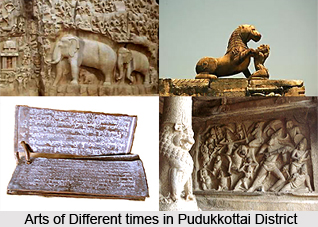 History of Pudukkottai district states its origin from the two districts of Tiruchirappalli and Thanjavur, when this district was carved out from these two districts on the fourteenth of January 1974. Presently, this district is composed of two Revenue Divisions, called the Pudukkottai and Aranthangi and nine taluks, called the Kulathur, Illuppur, Gandarvakottai, Alangudi, Thirumayam, Aranthangi, Pudukkottai, Avudaiyrakoil and Manamelkudi. There are seven hundred and sixty five Revenue villages in this district. The total area of this district is four thousand six hundred and sixty three square kilometres. Most of the villages of this district are of ancient foundation. The district was one of the homes of pre-historic man and the presence of a large number of burial sites found in the northern and western parts of the district attest this fact.
History of Pudukkottai district states its origin from the two districts of Tiruchirappalli and Thanjavur, when this district was carved out from these two districts on the fourteenth of January 1974. Presently, this district is composed of two Revenue Divisions, called the Pudukkottai and Aranthangi and nine taluks, called the Kulathur, Illuppur, Gandarvakottai, Alangudi, Thirumayam, Aranthangi, Pudukkottai, Avudaiyrakoil and Manamelkudi. There are seven hundred and sixty five Revenue villages in this district. The total area of this district is four thousand six hundred and sixty three square kilometres. Most of the villages of this district are of ancient foundation. The district was one of the homes of pre-historic man and the presence of a large number of burial sites found in the northern and western parts of the district attest this fact.
The history of this district is an epitome of the history of South India. In and around Pudukkottai, there are several vestiges of the oldest habitations of man and some of the lithic records known in the south. The Pandyas, Cholas, Pallavas, Haysalas, Vijaynagar and Madurai Nayaks ruled over this part of the state of Tamil Nadu and fostered the communal organizations, trade and industries and embellished it with temples and monuments of great merit.
The Pudukkottai district was under the Pandyas of the first empire during the Sangam Age, but some part of the northern boundary of this district had been under the influence of the Cholas of Uraiyur, since a few villages in this place bear the prefix like `killi` and `valavan`, both of which are the titles used by the Cholas. From about the last of the fourth century about the last quarter of sixth, the district of Pudukkottai, like many other parts of Tamil Nadu was under the Kalabhras. It must have come under the King Kurran, whose inscriptions were found in Pulankurichi near Ponnamaravathi in the district. The next phase in this district`s history follows the overthrow of Kalabharas by  Kadungon in Pandya country about 590 AD. The first Pandya Dynasty inaugurated by Kadungon spread in to the district. It is shown by the presence of inscription of the rulers of this dynasty in Kudumianmalai, Thirugokarnam and Sittannavasal. The river Vellar that flows north of Pudukkottai town has been from the ancient times was the traditional boundary separating the terrains of the Cholas and Pandyas. This dividing line formed the Konadu and Kanadu, on the north and south respectively. Thus the district became a kind of marchar land between the Pandyas and Pallavas. The Pandyas and Pallavas carried on the wars by proxy through their subordinate chiefs the Mutharayars and Velirs. Among the Velirs, the most prominent are the Irukkuvels of Kodumbalur. The Kodumbalur Velirs were situated in the political buffer zone between the kingdoms of the Cholas and Pandyas and formed the family of nobility from which kings and other chiefs made matrimonial alliance.
Kadungon in Pandya country about 590 AD. The first Pandya Dynasty inaugurated by Kadungon spread in to the district. It is shown by the presence of inscription of the rulers of this dynasty in Kudumianmalai, Thirugokarnam and Sittannavasal. The river Vellar that flows north of Pudukkottai town has been from the ancient times was the traditional boundary separating the terrains of the Cholas and Pandyas. This dividing line formed the Konadu and Kanadu, on the north and south respectively. Thus the district became a kind of marchar land between the Pandyas and Pallavas. The Pandyas and Pallavas carried on the wars by proxy through their subordinate chiefs the Mutharayars and Velirs. Among the Velirs, the most prominent are the Irukkuvels of Kodumbalur. The Kodumbalur Velirs were situated in the political buffer zone between the kingdoms of the Cholas and Pandyas and formed the family of nobility from which kings and other chiefs made matrimonial alliance.
The period of three centuries between 600 and 900 AD relates to the reign of the Pallavas of Kanchi and Pandyas of Madurai who ruled over the entire Tamil Nadu with their boundary in between their empires oscillating on either side of Kaveri River the bone of contention being Cholamandalam, the home of Cholas, and the fertile Kaveri delta that was the granary of the south and as such always been the cynosure of all powers contending for supremacy during the entire historical period. The Cholas themselves were in eclipse and hibernating only to revive again in the ninth century, when the Pallava power came to an end, the Pandyas were holding on for some more time to yield place ultimately to the waxing Chola power.
Jainism well flourished in Pudukkottai area up to the eleventh century. There are a number of Jain vestiges in the district. The Buddhist vestiges in the district come from the former Thanjavur district. Buddha idols are found at Kottaipattinam and Karur. With the exit of Pallavas from the political scene and the subsequent elimination of the Pandya power by the Cholas, the Cholas established themselves at Thanjavur as their capital at the close of ninth century. They extended their sway by the eleventh century and Pudukkottai among many other places came under them. Their rule extended till about the middle of the thirteenth century when the Pandyas staged a comeback. The history of the district after the fall of Cholas could not be told in detail for the records are comparatively minimal. The Pandyas of the second empire spread their influence in the district gradually. The brief history of this district covering a period of over two millennia helps in giving an insight into the variety, nature, origin, chronology and importance of the monuments and their inscriptions, architecture, sculptures iconography and other aesthetic contents.
Administration of Pudukkottai District
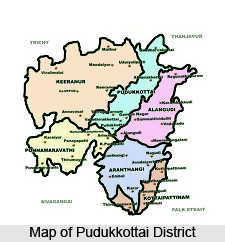 Administration of Pudukkottai district in Tamil Nadu has the collector as the head and various other officers to assist the collector in the general administration of the district. The district Collector controls the Revenue and Rural Development units of the district administration through his Personal Assistants and Panchayat Development officers. The district of Pudukkottai is divided into two revenue divisions and eleven taluks consisting of seven hundred and fifty seven revenue villages. District Revenue Officer, helps the District Collector in all his responsibilities and he is also the authority for the land matters of the district. Revenue collection in the district is determined by the District Revenue Officer. The District Revenue Officer grants several licenses, in the capacity of Additional District Magistrate.
Administration of Pudukkottai district in Tamil Nadu has the collector as the head and various other officers to assist the collector in the general administration of the district. The district Collector controls the Revenue and Rural Development units of the district administration through his Personal Assistants and Panchayat Development officers. The district of Pudukkottai is divided into two revenue divisions and eleven taluks consisting of seven hundred and fifty seven revenue villages. District Revenue Officer, helps the District Collector in all his responsibilities and he is also the authority for the land matters of the district. Revenue collection in the district is determined by the District Revenue Officer. The District Revenue Officer grants several licenses, in the capacity of Additional District Magistrate.
The Project Officer, District Rural Development Agency, implements the various schemes of the Government for the rural welfare in this district of Tamil Nadu state. The District Collector has authorized the Project Officer to extend the basic like drinking water, street light and Rural Housing Scheme to the people. The District Supply officer manages the Public Distribution System in co-ordination with the Joint Registrar of Co-operatives, while the Special Deputy Collector for Public Grievance Redressed Cell, attends to the grievances submitted to the Collector and the grievances submitted to the Chief Minister regarding the district of Pudukkottai. The District Collector has two district level officers, one for the welfare of the Adi-Dravidar and another for the Backward Classes and Minorities.
The district`s Public health system and the maintenance of Government Hospitals are supervised by the District Collector through the Joint Director of Public Health, Pudukkottai. The Deputy Director of Public Health maintains the rural health system and Primary Health Centers available at the villages under the supervision of the District Collector. The collector of this district also monitors the agricultural and animal husbandry activities in this district through the Joint Director of Agriculture and Assistant Director of Animal Husbandry respectively at Pudukkottai.
The collector of Pudukkottai district also commands the works of the chief educational officer, district educational officer and district elementary educational officer who manage the educational institutions up to the higher secondary level. The district collector executes works relating to irrigation through the public works department authorities and road management through the divisional engineer, highways (Pudukkottai). The collector of the district of Pudukkottai also monitors the welfare actions of the Banking units in the district. In the capacity of the District Magistrate, the Collector also grants various licenses. The Superintendent of Police maintains the Law and Order and exercises the prohibition in the district.
Education in Pudukkottai District
The total population of the district of Pudukkottai in the Tamil Nadu state is 14, 59,601 and the total number of literates in the district is 9, 07,306. Education is well-developed in this district with four arts and science colleges, about seven colleges for professional education, about one thousand four hundred and thirty one schools for general education, about sixteen institutions for other professional education, etc.
Temples of Pudukkottai District
 Temples of Pudukkotai district in Tamil Nadu reflect the archaeological and cultural excellence of the artisans and craftsmen. Pudukkottai District is surrounded by Tiruchirapalli District in the north and west, Sivagangai District in the south, Thanjavur District in the northeast and the Bay of Bengal in the east. The archaeological and cultural remains at Kodumbalur, Narthamalai, Kudumianmalai, Kunnandarkoil, Sittannavasal, Thirumayam and Avudayarkoil prove its rich cultural heritage, through magnificent temples of Pudukkotai district. Dolmens, stone circles and megalithic burials reveled many ancient temples of Pudukkotai district, thus indicating its antiquity. Aadi Pogrom Festival at Sri Kokarneswarar Brahadambal Temple and Manikkavasagar festival at Avudayarkoil are the major festivals of the district.
Temples of Pudukkotai district in Tamil Nadu reflect the archaeological and cultural excellence of the artisans and craftsmen. Pudukkottai District is surrounded by Tiruchirapalli District in the north and west, Sivagangai District in the south, Thanjavur District in the northeast and the Bay of Bengal in the east. The archaeological and cultural remains at Kodumbalur, Narthamalai, Kudumianmalai, Kunnandarkoil, Sittannavasal, Thirumayam and Avudayarkoil prove its rich cultural heritage, through magnificent temples of Pudukkotai district. Dolmens, stone circles and megalithic burials reveled many ancient temples of Pudukkotai district, thus indicating its antiquity. Aadi Pogrom Festival at Sri Kokarneswarar Brahadambal Temple and Manikkavasagar festival at Avudayarkoil are the major festivals of the district.
Government Museum at Thirukokarnam, Aintali Temple at Kodumbalur, Muskundeshwarar Temple, rock-cut cave temple at Kodumianmalai, Subramanya Temple at Viralimalai, Thirumayam Fort and Old chapel at Avur are the main temples of Pudukkotai district. Arulmighu Meenakshi Chokkeswarar Temple boasts a beautiful shrine in Pudukkottai District. This temple of Pudukkotai district is famous for the Nandi, known as Nei Nandi. Although the Nandi is made of black granite, it shines like marble because of the frequent abhisheks with pure ghee. Thousands of devotees visit the temples of Pudukkotai district every year.
Muchukondeswar Temple, one of the important temples of Pudukkotai district, is situated at Kodumbalur village and was constructed by Irukkuvelar, the chieftain who ruled over here during the 9th-10th century. Pazhampati Nathar Temple, one of the temples of Pudukkotai district, lies on the seashore of the Pandya country and is protected by massive walls. The temple dates back to the Pandya period. The Nandi, the Shivalingam, and the vimana crowning the sanctum are huge remarkable structures. The main festival held in this temple is the annual Brahmotsavam festival conducted in the month of Vaikasi. Sathyamurthy Perumal Temple is another temple of Pudukkotai district, dedicated to Lord Vishnu. Thirumayam is known as one of the 108 Tirupathis.
Recently archeologists have found many inscriptions belonging to the Chola period on the temples of Pudukkotai district. The nearest railheads to reach the temples of Pudukkotai district are Tiruchirapalli and Pudukottai.
Tourism in Pudukkottai
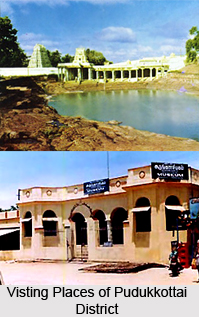 Tourism in Pudukkottai comprised of a number of interesting places in Pudukkottai which further enhances the tourist quotient. The main interesting places in Pudukkottai are the Sri Kokarneswar Temple and the Government Museum.
Tourism in Pudukkottai comprised of a number of interesting places in Pudukkottai which further enhances the tourist quotient. The main interesting places in Pudukkottai are the Sri Kokarneswar Temple and the Government Museum.
Sri Kokarneswar Temple
This is a temple of Pallava period. It is a rock-cut cave temple of Mahendravarma Pallava. Kokarneswarar and his consort Brahadambal are the presiding deity of this temple. Later, some additions were made by others. Here, the idols of Ganesa, Gangadhara and Saptha Kannikas are artistic creations of perennial value.
There is an image of the saint Sadasiva Brahmendra at the foot of a Bikula tree in this temple here in Pudukkottai. The deity of this temple is the family deity of the Raja. Here, the king released coins called `Amman Kasu` in reverence of Brahadambal.
Government Museum
This museum is located in Thirukkokarnam. Here, one can see the interesting and wide collections in the sections of Geology, Zoology, Paintings, Anthropology, Epigraphy, Historical Records etc. The main attractions here are the fine sculptures and bronzes of various periods. One can visit this museum of Pudukkottai at any time between 9 a.m. to 5 p.m. without any admission fee. The museum remains closed only during Fridays.
Sittannavasal
This ancient abode of Jains can be traced back to the 2nd century B.C. It is situated 16 kms from Pudukkottai. The main attractions here are the rock-cut cave temple and its beautiful paintings in natural colours. The stone beds called Eladipattam and a cave where the Jain monks sought refuge in those days also attract the visitors. The images of Jain Tirtankaras can be seen in an `Ardha Mandapam` and in the inner shrines of the cave temple. The paintings in the ceilings and walls of the temple contain paintings that resemble Ajanta paintings. Some of them have got damaged but still looks attractive. The flowers, calves, elephants, geese, all of them are depicted in unique poses and all relate to the Jains. All these are creation of the Pandyas. One can reach there easily as there are frequent bus services.
Kudumiyanmalai
This place is situated 20 kms far from Pudukkottai. Here is a temple called Sikharagireeswarar, which contain exquisite sculptures and a 1000-pillared hall. Among the numerous inscriptions found in this temple, the quite interesting one is that of Mahendra Varma Pallavan. He made a treatise on music here, especially on the seven notes called Saptha Swara. Mahendra Varma Pallavan built another rock-cut temple here in Pudukkottai above called `Melakkoil`.
Kodumbalur
This place is 36 kms away from Pudukkottai and is also known as Moovar Koil. Of the Moovar Koil (Three temples) only two exist here now. Boodhi Vikrama Kesari, a general of the Chola army in the 10th century A.D built this temple. The Pandyas and the Pallavas had fierce battles between them here. This temple has unique architecture compared to other temples in south India. Other unique masterpieces of this temple are the sculptures of Kalarimurthi, Gaja (Elephant) Samharamurthi and Gangadaramurthi etc.
Viralimalai temple
This is a temple of Lord Muruga. It is built here on a hillock. This is a 15th century temple. The presiding deity of this temple can be seen seated on a peacock mount with his two spouses Valli and Deivayanai. There is also a peacock sanctuary here, which is 40 kms from Pudukkottai.
Narthamalai
It is 17 kms from Pudukkottai. Here, on the hillsides, several Jain monasteries can be seen. There are several rare medicinal plants and herbs such as black gooseberry (Karunelli), Jathi tree etc. in the forest here. It was also the capital of Mutharaiyar chieftains. The important visiting places here are the earliest structural stone temple, circular in shape built by Mutharaiyars, the Vijayalaya Choleswaram cave temple built by Vijayalaya the first king of the later Cholas and Kadambar Malai temple.
Thirumayam
This place is situated about 19 kms from Pudukkottai. The important tourist attractions here are the fort, the Siva and the Vishnu temples. The Vijaya Ragunatha Sethupathi of Ramanathapuram built this 40 acre wide fort in 1687 A.D. There is a rock-cut Siva temple with inscriptions on music on the hill here. The remnants of another fort can also be seen here. The Siva and Vishnu temples are there at the foot of the hill. The largest Anantasayi in India can be seen in the Vsihnu temple here. It is a natural cave, which has been changed into a shrine. An old chain armour used by Oomaithurai, who was imprisoned here can be seen here.
Avudayar Koil
This temple is situated 40 kms from Pudukkottai. It is also called Thiruperunthurai. Atmanatha is the presiding deity of this temple. The unique features of this temple include that, there is no Lingam in the sanctum and only the Avudayar or its bottom pedestal is worshipped. There is no display of the goddess here in any form. The deity is also not offered any Neivedyam. Nandi, the mount of Siva usually in front of the deity is also absent here.
This is the only Saivaite shrine in the whole of India, which portrays the supreme truth symbolically. The deity here is called Atmanathar as the soul has no form. Manicka Vasagar, one of the 63 Saivaite saints built this temple. It is said that he spent all the money he got for purchasing horses for the Pandya king in building this temple.
The temple is renowned for its zephyr (granite roof) work. The ceiling of the Kanaka Sabhai is a superb creation in stone. The rope, rafters and nails are all in granite. The bow wielding Muruga, Kali and Siva`s Rudra
Thandavam are the finest specimens in sculptural art.
Avur
It is 28 kms from Pudukkottai and this place is famous for churches. The new Roman Catholic Church here was built in 1747 A.D. The old chapel here was constructed by Fr John Venatius Bachet in 1547 A.D. The Easter Passion play here is followed by car festival in summer, which attracts thousands of people of all faiths.
Kumaramalai
This is a temple of Lord Muruga, which is situated about 10 kms from Pudukkottai. It is located at a small hill. The name Kumaramalai is given because Kumaran is another name for Lord Muruga. The tank water of this hill is considered to be holy.
Kattubava Pallivasal
This is an important Islamic pilgrim centre, situated about 30 kms from Pudukkottai. It is located on the Thirumayam-Madurai highway. The devotees of all faiths visit here. The annual `Urs` occur in the month of Rabiyul Ahir.
Vendanpatti
It is situated about 40 kms from Pudukkottai on the way to Ponnamaravathi. Here, the Nandi of the Meenakshi Chokkeswarar temple is known as `Nei Nandhi` (Ghee Bull) and it is very famous. This is made of black granite but still shines like marble due to frequent ablutions with pure ghee. It is surprising to see that there are no flies or ants despite the Nandi being showered with pure ghee daily. This temple is visited by large number of devotee everyday.
Aranthangi
This city is the second largest in Pudukkottai. Numerous people visit here to see the ruined fort, the walls of which are constructed with mud and with bricks or stones. There are no ruins of palaces or any striking building inside the fort. The construction date of the fort is not known. But, the Tondaimans, who had no connections with those of Pudukkottai, are believed to have constructed it. There is also an eleventh century A.D. temple here, which was built by Rajendra Chola Varman.
Government Museum at Pudukkottai
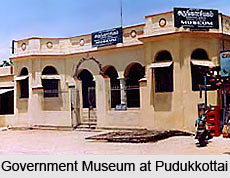 The Government Museum at Pudukkottai in the state of Tamil Nadu was established in the year 1910. It is a multipurpose museum.
The Government Museum at Pudukkottai in the state of Tamil Nadu was established in the year 1910. It is a multipurpose museum.
The objects that are exhibited in the museum include geology, zoology, anthropology, economic, botany, epigraphy, painting, numismatics, sculptures, bronzes and objects of arts and industries.
Interested people may visit the museum between 9:30am to 5pm. The museum remains closed on Fridays, second Saturdays, Republic Day, Independence Day and also on Gandhi Jayanti.
Tourist places around Pudukkottai District
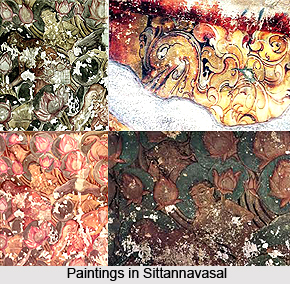 There are large numbers of interesting tourist places around Pudukkottai, which attract the visitors. Some of the important tourist places of Pudukkottai include Sittannavasal, Kudumiyanmalai, Kodumbalur, Aranthangi etc. Some of them are given here:
There are large numbers of interesting tourist places around Pudukkottai, which attract the visitors. Some of the important tourist places of Pudukkottai include Sittannavasal, Kudumiyanmalai, Kodumbalur, Aranthangi etc. Some of them are given here:
Sittannavasal
This ancient abode of Jains can be traced back to the 2nd century B.C. It is situated 16 kms from Pudukkottai.
The main attractions here are the rock-cut cave temple and its beautiful paintings in natural colours. The stone beds called Eladipattam and a cave where the Jain monks sought refuge in those days also attract the visitors. The images of Jain Tirtankaras can be seen in an `Ardha Mandapam` and in the inner shrines of the cave temple. The paintings in the ceilings and walls of the temple contain paintings that resemble Ajanta paintings. Some of them have got damaged but still looks attractive. The flowers, calves, elephants, geese, all of them are depicted in unique poses and all relate to the Jains. All these are creation of the Pandyas. One can reach there easily as there are frequent bus services.
Kudumiyanmalai
This place is situated 20 kms far from Pudukkottai. Here is a temple called Sikharagireeswarar, which contain exquisite sculptures and a 1000-pillared hall. Among the numerous inscriptions found in this temple, the quite interesting one is that of Mahendra Varma Pallavan. He made a treatise on music here, especially on the seven notes called Saptha Swara.
Mahendra Varma Pallavan built another rock-cut temple here in Pudukkottai above called `Melakkoil`.
Kodumbalur
This place is 36 kms away from Pudukkottai and is also known as Moovar Koil. Of the Moovar Koil (Three temples) only two exist here now. Boodhi Vikrama Kesari, a general of the Chola army in the 10th century A.D built this temple. The Pandyas and the Pallavas had fierce battles between them here. This temple has unique architecture compared to other temples in south India. Other unique masterpieces of this temple are the sculptures of Kalarimurthi, Gaja (Elephant) Samharamurthi and Gangadaramurthi etc.
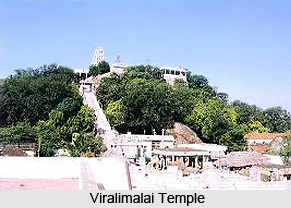 Viralimalai temple
Viralimalai temple
This is a temple of Lord Muruga. It is built here on a hillock. This is a 15th century temple. The presiding deity of this temple can be seen seated on a peacock mount with his two spouses Valli and Deivayanai. There is also a peacock sanctuary here, which is 40 kms from Pudukkottai.
Narthamalai
It is 17 kms from Pudukkottai. Here, on the hillsides, several Jain monasteries can be seen. There are several rare medicinal plants and herbs such as black gooseberry (Karunelli), Jathi tree etc. in the forest here. It was also the capital of Mutharaiyar chieftains. The important visiting places here are the earliest structural stone temple, circular in shape built by Mutharaiyars, the Vijayalaya Choleswaram cave temple built by Vijayalaya the first king of the later Cholas and Kadambar Malai temple.
Thirumayam
This place is situated about 19 kms from Pudukkottai. The important tourist attractions here are the fort, the Siva and the Vishnu temples. The Vijaya Ragunatha Sethupathi of Ramanathapuram built this 40 acre wide fort in 1687 A.D.
There is a rock-cut Siva temple with inscriptions on music on the hill here. The remnants of another fort can also be seen here. The Siva and Vishnu temples are there at the foot of the hill. The largest Anantasayi in India can be seen in the Vsihnu temple here. It is a natural cave, which has been changed into a shrine. An old chain armour used by Oomaithurai, who was imprisoned here can be seen here.
Avudayar Koil
This temple is situated 40 kms from Pudukkottai. It is also called Thiruperunthurai. Atmanatha is the presiding deity of this temple. The unique features of this temple include that, there is no Lingam in the sanctum and only the Avudayar or its bottom pedestal is worshipped. There is no display of the goddess here in any form. The deity is also not offered any Neivedyam. Nandi, the mount of Siva usually in front of the deity is also absent here.
This is the only Saivaite shrine in the whole of India, which portrays the supreme truth symbolically. The deity here is called Atmanathar as the soul has no form. Manicka Vasagar, one of the 63 Saivaite saints built this temple. It is said that he spent all the money he got for purchasing horses for the Pandya king in building this temple.
The temple is renowned for its zephyr (granite roof) work. The ceiling of the Kanaka Sabhai is a superb creation in stone. The rope, rafters and nails are all in granite. The bow wielding Muruga, Kali and Siva`s Rudra
Thandavam are the finest specimens in sculptural art.
Avur
It is 28 kms from Pudukkottai and this place is famous for churches. The new Roman Catholic Church here was built in 1747 A.D. The old chapel here was constructed by Fr John Venatius Bachet in 1547 A.D. The Easter Passion play here is followed by car festival in summer, which attracts thousands of people of all faiths.
Kumaramalai
This is a temple of Lord Muruga, which is situated about 10 kms from Pudukkottai. It is located at a small hill. The name Kumaramalai is given because Kumaran is another name for Lord Muruga. The tank water of this hill is considered to be holy.
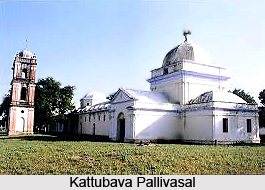 Kattubava Pallivasal
Kattubava Pallivasal
This is an important Islamic pilgrim centre, situated about 30 kms from Pudukkottai. It is located on the Thirumayam-Madurai highway. The devotees of all faiths visit here. The annual `Urs` occur in the month of Rabiyul Ahir.
Vendanpatti
It is situated about 40 kms from Pudukkottai on the way to Ponnamaravathi. Here, the Nandi of the Meenakshi Chokkeswarar temple is known as `Nei Nandhi` (Ghee Bull) and it is very famous. This is made of black granite but still shines like marble due to frequent ablutions with pure ghee. It is surprising to see that there are no flies or ants despite the Nandi being showered with pure ghee daily. This temple is visited by large number of devotee everyday.
Aranthangi
This city is the second largest in Pudukkottai. Numerous people visit here to see the ruined fort, the walls of which are constructed with mud and with bricks or stones. There are no ruins of palaces or any striking building inside the fort. The construction date of the fort is not known. But, the Tondaimans, who had no connections with those of Pudukkottai, are believed to have constructed it. There is also an eleventh century A.D. temple here, which was built by Rajendra Chola Varman.



















